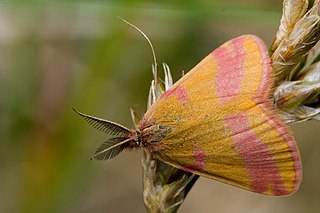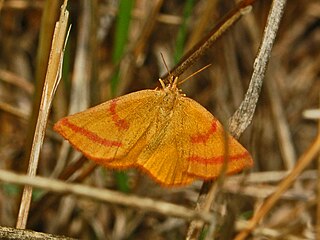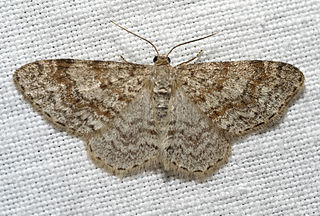
The geometer moths are moths belonging to the family Geometridae of the insect order Lepidoptera, the moths and butterflies. Their scientific name derives from the Ancient Greek geo γεω, and metron μέτρον "measure" in reference to the way their larvae, or "inchworms", appear to "measure the earth" as they move along in a looping fashion. A very large family, it has around 23,000 species of moths described, and over 1400 species from six subfamilies indigenous to North America alone. A well-known member is the peppered moth, Biston betularia, which has been subject of numerous studies in population genetics. Several other geometer moths are notorious pests.

The Macariini are a tribe of geometer moths in the subfamily Ennominae. Though they share many traits with the Sterrhinae, this is probably plesiomorphic rather than indicative of a close relationship, and DNA sequence data points to the Boarmiini as particularly close relatives of the Macariini. All things considered, this tribe might still resemble the first Ennominae more than any other living lineage in the subfamily.

Scopula immorata, the Lewes wave, is a moth of the family Geometridae. It is found throughout Europe and the Near East.

Cyllopoda is a genus of moths in the family Geometridae.
Isoplenodia is a genus of moths in the family Geometridae. It formerly consisted of only one species, Isoplenodia arrogans, found on Madagascar, but new species were described in 2010.

Lipomelia is a monotypic moth genus in the family Geometridae. It contains only one species, Lipomelia subusta, which is found in India and Taiwan. Both the genus and species were first described by William Warren in 1893.

Lythria is a genus of moths in the family Geometridae erected by Jacob Hübner in 1823. It is the only genus of the monotypic tribe Lythriini described by Claude Herbulot in 1962.

Rhodostrophia is a genus of moths in the family Geometridae erected by Jacob Hübner in 1823.

Somatina is a genus of moths in the family Geometridae first described by Achille Guenée in 1858.

Sterrhinae is a large subfamily of geometer moths with some 3,000 described species, with more than half belonging to the taxonomically difficult, very diverse genera, Idaea and Scopula. This subfamily was described by Edward Meyrick in 1892. They are the most diverse in the tropics with the number of species decreasing with increasing latitude and elevation.

Rhodostrophia calabra is a moth of the family Geometridae first described by Vincenzo Petagna in 1786. It is found from the Iberian Peninsula and a small isolated population in Morocco, through southern France, the western and southern Alps, Italy, the eastern coast of the Adriatic Sea to the southern parts of the Balkan Peninsula. In central Europe it is only found as an isolated population in central France and Rheinland-Pfalz. It is not found on the islands in the Mediterranean Sea. In the Balkans there is an isolated population in the border region of northern Bulgaria and Serbia. Furthermore, it is present on the eastern shores of the Black Sea in Turkey and in the Caucasus.

Lythria purpuraria, the purple-barred yellow, is a species of moth of the family Geometridae. It is found from western Europe to Siberia, Russia, Ukraine, Turkmenistan and Kazakhstan.

Asthenini is a tribe of geometer moths under subfamily Larentiinae first described by Warren in 1893. The tribe has been combined with Eupitheciini in the past, most notably by Jeremy Daniel Holloway in his work The Moths of Borneo.
Louis Beethoven Prout (1864–1943) was an English entomologist and musicologist.
Scopula apicipunctata is a moth of the family Geometridae. It was described by Hugo Theodor Christoph in 1881. It is found in Siberia, the Kuriles and Japan.
Scopula diffinaria is a moth of the family Geometridae. It is found in Armenia, Georgia, Russia and Turkey.
Scopula impersonata is a moth of the family Geometridae. It is found in China, the Russian Far East, Taiwan and Japan.
Scopula superior is a moth of the family Geometridae. It was described by Arthur Gardiner Butler in 1878. It is found in Japan, the Russian Far East and China.
Rhodostrophiini is a tribe of the geometer moth family (Geometridae), with about 200 species in 17 genera and five genera tentatively associated with the tribe.











